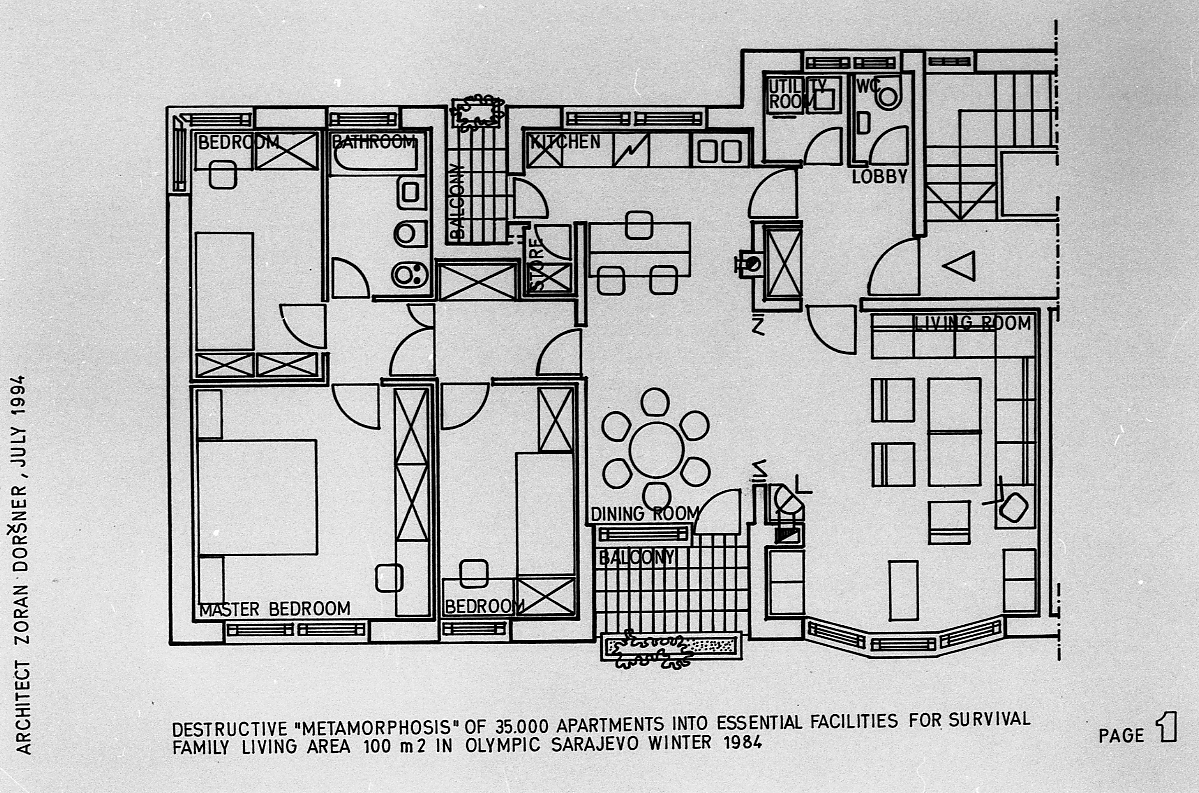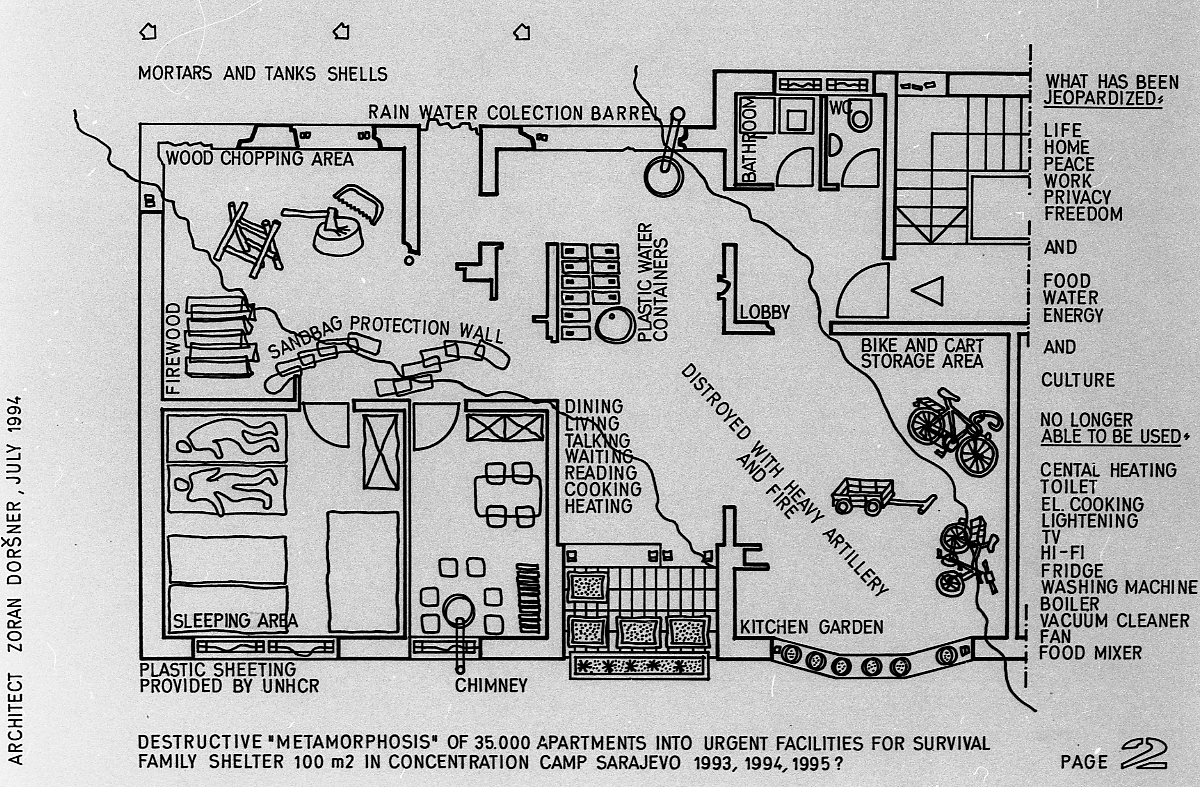1992-1996
Abstract
The research shows experiences of the war in Sarajevo from the citizens’ point of view, learned from architectural drawings, videos, photos, and other media projects from the war, different from sensational media representations. The results display how citizens in Sarajevo have been responding to the military violence during the siege between 1992-1996, relying on all available architectural and other materials. The newly developed x-media analysis includes the study of analogue and digital media documents on the war in Sarajevo, and a translation of the analogue materials to the digital materials for exhibitions or lectures. A virtual reality model includes a 3D model of the city and a transformed by war modernist apartment. Archival photos and videos from the war are collected in the open source digital archive ‘un-war space’.

Figure 1: During the war the architectural program of typically modernist dwellings has been transformed into self-programmed spaces, unique from one another, each containing the resources for specific human lives and survival as documented in 1994 by architect Zoran Doršner.

Figure 2: Design objects and spatial innovations as for example: production of electricity, rain water collection, cooking and lighting devices.
Destruction of the architecture and the city during the war starts to materialize with the disturbing noise of the weapons and cracking of the windows glass, moving of the land, bombs explosions on the individual and collective houses, public buildings, streets, parks and sadly on humans. We can observe destruction of the city by means of bombing, distant occupation and control of the public space from the sniper positions as the processes of un-doing architecture, the city, and at the same time as an extraordinary condition of reproduction of ephemeral spaces by citizens’ for protection and survival.
Un-war space is part of a research process about architectural and other materials that analyzes entanglements of war and un-war spaces during the siege of Sarajevo between 1992-1996, the bodily adaptation and human relations within, and new codes of knowledge formed on the edge of the military and civilian actions. I assume war as violent spatial condition supported and created by the military apparatus, while the ‘un-war’ as non-violent spatial condition created by citizens, that through adaptation and survival are in the processes of normalization of their life within the war condition, and without using weapons.
Personal experiences of the war are all unique, and the human body reacts in varied ways to destruction, internal or long-distance displacement, noise (military aircraft, sirens, grenades, guns), lack of resources (food, water, electricity), and exposure to extreme heat and cold. War violent activities in Sarajevo re-defined the landscape, the city, codes of spatial knowledge, the notion of citizenship, and above all the body’s abilities to adapt to the dangerous urban environment.
The VR-model and lenticular prints are exploring and displaying un-war space in Sarajevo in three different scales of war transformations: (1) military siege of the natural and urban landscape, (2) transitional spaces from prewar to the war urban conditions of citizens’ everyday life and production of space through processes of adaptation to the war geographies and destruction, (3) rescaling processes of the typical modernist apartment into self-programed space containing recourses and architectural elements for survival.
The VR-model is based on the architectural drawings of the architect Zoran Doršner made in 1993 in besieged Sarajevo, videos, photos and other media projects dating from the war and today partly stored on the on-line open source archive entitled un-war space. The exhibition is an open and unfinished project with an attempt to display partly how citizens through spatial activities and available architectural and other materials were undoing war in Sarajevo between 1992-1996.
Acknowledgement
Contributors to the exhibition and un-war space archive
Architect Zoran Doršner, photographer Zoran Kanlić, photographer Paul Lowe, film director Frank Vellenga, war archive of the Museum of History of Bosnia and Herzegovina, private film archive of the film director Dom Rotheroe, TU Delft students’ graduation projects on Sarajevo: Alessandro Arcangeli, Kasia Piekarczyk, Gaila Costantini.
VR modelling
Arno Freeke, Luuc Goossen, Arend Jan Krooneman.
Video editing
Matija Kralj and Ravenna Westerhout.
The exhibition is supported by Chair of Methods and Analysis and VR-lab of the Faculty of Architecture - TU Delft. It is one of the research outcomes of un-war space/evidencity research project in the framework of Marie Curie IF research fund awarded to Dr. Armina Pilav in 2016 within EU research and innovation program Horizon 2020.
References
Pilav, A. (2012). Before the war, war, after the war: Urban imageries for urban resilience. International Journal of Disaster Risk Science, 3(1), 23-37.
Pilav, A. (2017). Sarajevo: Material Mediation and Survival Body. The Funambulist, (11), 40-43.
Pilav, A. (2017, APRIL 13). Building Again [Web log post]. Retrieved from http://blog.architectuul.com/post/159514312657/building-again
Pilav, A. (2018). Un-war Space. Retrieved from http://unwarspace.bk.tudelft.nl